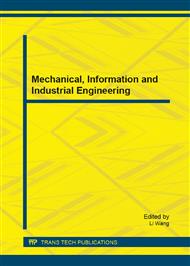p.433
p.438
p.442
p.446
p.450
p.456
p.460
p.466
p.470
Study on Improving Consumption Capability of Wind Power by Installing Thermal Storage in Ningxia Province
Abstract:
With the rapid development of wind power industry, the wind power absorption problem has become an increasingly severe challenge which China's power industry is faced with. In fact, through the configuration of large capacity thermal storage devices in the existing power system, an electrothermal association system is formed by combining electric power system with thermal system, which can not only increase the peak load regulation capacity of the system, but also increase local load, thus greatly improving the wind power absorptive capacity of electric power system. This paper will make an systematic analysis of the mechanism of promoting the wind power absorptive capacity of electric power system by utilizing thermal storage devices, and the feasibility and prospect of the proposed plan by combining with the actual situation of Ningxia, and lays the foundation for the further study of thermal storage devices in electrical power system.
Info:
Periodical:
Pages:
450-455
Citation:
Online since:
March 2015
Authors:
Price:
Сopyright:
© 2015 Trans Tech Publications Ltd. All Rights Reserved
Share:
Citation:


